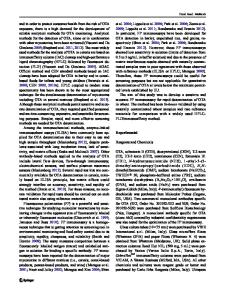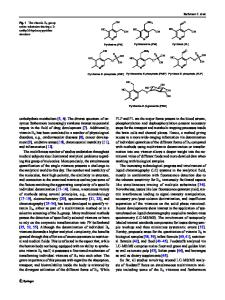Development of a Sensitive and Accurate Stable Isotope Dilution Assay for the Simultaneous Determination of Free 4-Hydro
- PDF / 329,910 Bytes
- 8 Pages / 595.276 x 790.866 pts Page_size
- 70 Downloads / 353 Views
Development of a Sensitive and Accurate Stable Isotope Dilution Assay for the Simultaneous Determination of Free 4-Hydroxy-2-(E)-Nonenal and 4-Hydroxy-2-(E)-Hexenal in Various Food Matrices by Gas Chromatography–Mass Spectrometry Antonios Papastergiadis & Edward Mubiru & Herman Van Langenhove & Bruno De Meulenaer Received: 3 June 2013 / Accepted: 19 July 2013 / Published online: 13 August 2013 # Springer Science+Business Media New York 2013
Abstract An analytical method suitable for the determination of 4-hydroxy-2-(E)-nonenal (HNE) and 4-hydroxy-2-(E)hexenal (HHE) in various food matrices was developed and validated. The method involves the use of deuterated HNE and HHE as internal standards, extraction of the analytes from the matrices followed by derivatization and detection with gas chromatography–mass spectrometry. Four different food matrices were chosen as model systems including vegetable oils, unprocessed meat, fried potato crisps, and infant formula and three different extraction techniques suitable for the different matrices were applied including the Quick Easy Cheap Effective Rugged Safe method. The simplicity of the extraction techniques allows the method to be applied for routine analysis of a large amount of samples. The results verify the accuracy and reproducibility of the analytical technique and its ability to provide reliable quantification of both analytes at concentrations as low as 12.8 ng g−1 in meat samples. Furthermore, a short overview of the levels of HNE and HHE in several products available in the Belgian market is presented.
Keywords Lipid oxidation . 4-Hydroxy-2-(E)-nonenal . Hydroxy-2-(E)-hexenal . QuEchERS
A. Papastergiadis : E. Mubiru : B. De Meulenaer (*) nutriFOODchem Unit, Department of Food Safety and Food Quality (partners in Food2Know), Faculty of Bioscience Engineering, Ghent University, Coupure Links 653, 9000 Ghent, Belgium e-mail: [email protected] H. Van Langenhove Research Group EnVOC, Department of Sustainable Organic Chemistry, Faculty of Bioscience Engineering, Ghent University, Ghent, Belgium
Introduction One of the main causes of chemical deterioration of foods, especially those containing polyunsaturated fatty acids (PUFA), is lipid oxidation (Belitz et al. 2009). Oxidation of unsaturated fatty acids leads to the formation of odorless and tasteless hydroperoxides, which further decomposed to flavorful secondary oxidation products mainly aldehydes. Hydroxylated unsaturated aldehydes such as 4-hydroxy-2-(E)nonenal (HNE) and 4-hydroxy-2-(E)-hexenal (HHE) have attracted the attention due to their toxicity to humans which is attributed to their high reactivity with proteins and DNA, consequently leading to structural damage and alteration of their functionality (Kinter 1995; StAngelo 1996; Esterbauer et al. 1991; Esterbauer 1982; Guillen and Goicoechea 2008a; Voulgaridou et al. 2011; Goicoechea et al. 2008; Goicoechea et al. 2011). HNE is formed during the oxidation of ω-6 PUFA, while HHE is mainly related to the oxidation of ω-3 PUFA (Long and Picklo 2010
Data Loading...











